Marketing Mix Report: Analyzing Product, Place, Promotion, and People
VerifiedAdded on 2020/11/30
|35
|12072
|290
Report
AI Summary
This report delves into the intricacies of the marketing mix, providing a comprehensive analysis of its key components. It begins by examining the role of product features and benefits in the marketing mix, emphasizing the importance of aligning product attributes with consumer needs. The report then explores the product life cycle, outlining the strategic application of the marketing mix across the introduction, growth, maturity, and decline phases. Distribution channels, both direct and indirect, are analyzed, highlighting their respective roles and advantages. The report also covers pricing strategies, promotional campaigns, and the significance of customer-facing staff in businesses. Furthermore, it explores the use of Customer Relationship Management (CRM) and marketing processes, emphasizing customer focus and the role of physical evidence in the marketing mix. The report provides a detailed overview of each element, offering insights into how businesses can effectively utilize the marketing mix to achieve their objectives.

The Marketing Mix
1
1
Paraphrase This Document
Need a fresh take? Get an instant paraphrase of this document with our AI Paraphraser
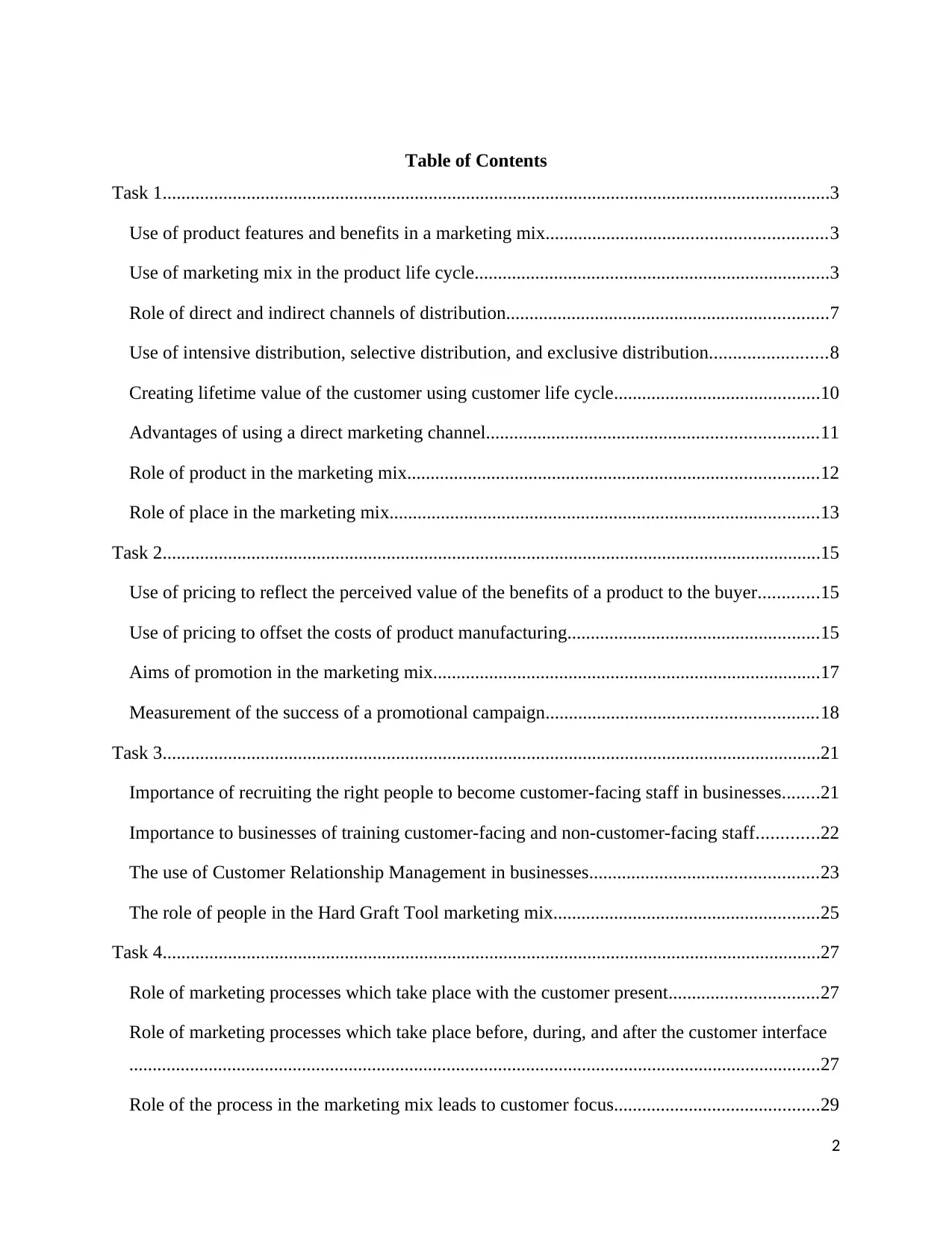
Table of Contents
Task 1...............................................................................................................................................3
Use of product features and benefits in a marketing mix............................................................3
Use of marketing mix in the product life cycle............................................................................3
Role of direct and indirect channels of distribution.....................................................................7
Use of intensive distribution, selective distribution, and exclusive distribution.........................8
Creating lifetime value of the customer using customer life cycle............................................10
Advantages of using a direct marketing channel.......................................................................11
Role of product in the marketing mix........................................................................................12
Role of place in the marketing mix............................................................................................13
Task 2.............................................................................................................................................15
Use of pricing to reflect the perceived value of the benefits of a product to the buyer.............15
Use of pricing to offset the costs of product manufacturing......................................................15
Aims of promotion in the marketing mix...................................................................................17
Measurement of the success of a promotional campaign..........................................................18
Task 3.............................................................................................................................................21
Importance of recruiting the right people to become customer-facing staff in businesses........21
Importance to businesses of training customer-facing and non-customer-facing staff.............22
The use of Customer Relationship Management in businesses.................................................23
The role of people in the Hard Graft Tool marketing mix.........................................................25
Task 4.............................................................................................................................................27
Role of marketing processes which take place with the customer present................................27
Role of marketing processes which take place before, during, and after the customer interface
....................................................................................................................................................27
Role of the process in the marketing mix leads to customer focus............................................29
2
Task 1...............................................................................................................................................3
Use of product features and benefits in a marketing mix............................................................3
Use of marketing mix in the product life cycle............................................................................3
Role of direct and indirect channels of distribution.....................................................................7
Use of intensive distribution, selective distribution, and exclusive distribution.........................8
Creating lifetime value of the customer using customer life cycle............................................10
Advantages of using a direct marketing channel.......................................................................11
Role of product in the marketing mix........................................................................................12
Role of place in the marketing mix............................................................................................13
Task 2.............................................................................................................................................15
Use of pricing to reflect the perceived value of the benefits of a product to the buyer.............15
Use of pricing to offset the costs of product manufacturing......................................................15
Aims of promotion in the marketing mix...................................................................................17
Measurement of the success of a promotional campaign..........................................................18
Task 3.............................................................................................................................................21
Importance of recruiting the right people to become customer-facing staff in businesses........21
Importance to businesses of training customer-facing and non-customer-facing staff.............22
The use of Customer Relationship Management in businesses.................................................23
The role of people in the Hard Graft Tool marketing mix.........................................................25
Task 4.............................................................................................................................................27
Role of marketing processes which take place with the customer present................................27
Role of marketing processes which take place before, during, and after the customer interface
....................................................................................................................................................27
Role of the process in the marketing mix leads to customer focus............................................29
2

Role of the process in the Hard Graft Tool marketing mix.......................................................30
Role of physical evidence in the Hard Graft Tool marketing mix.............................................31
Reference...................................................................................................................................32
3
Role of physical evidence in the Hard Graft Tool marketing mix.............................................31
Reference...................................................................................................................................32
3
⊘ This is a preview!⊘
Do you want full access?
Subscribe today to unlock all pages.

Trusted by 1+ million students worldwide
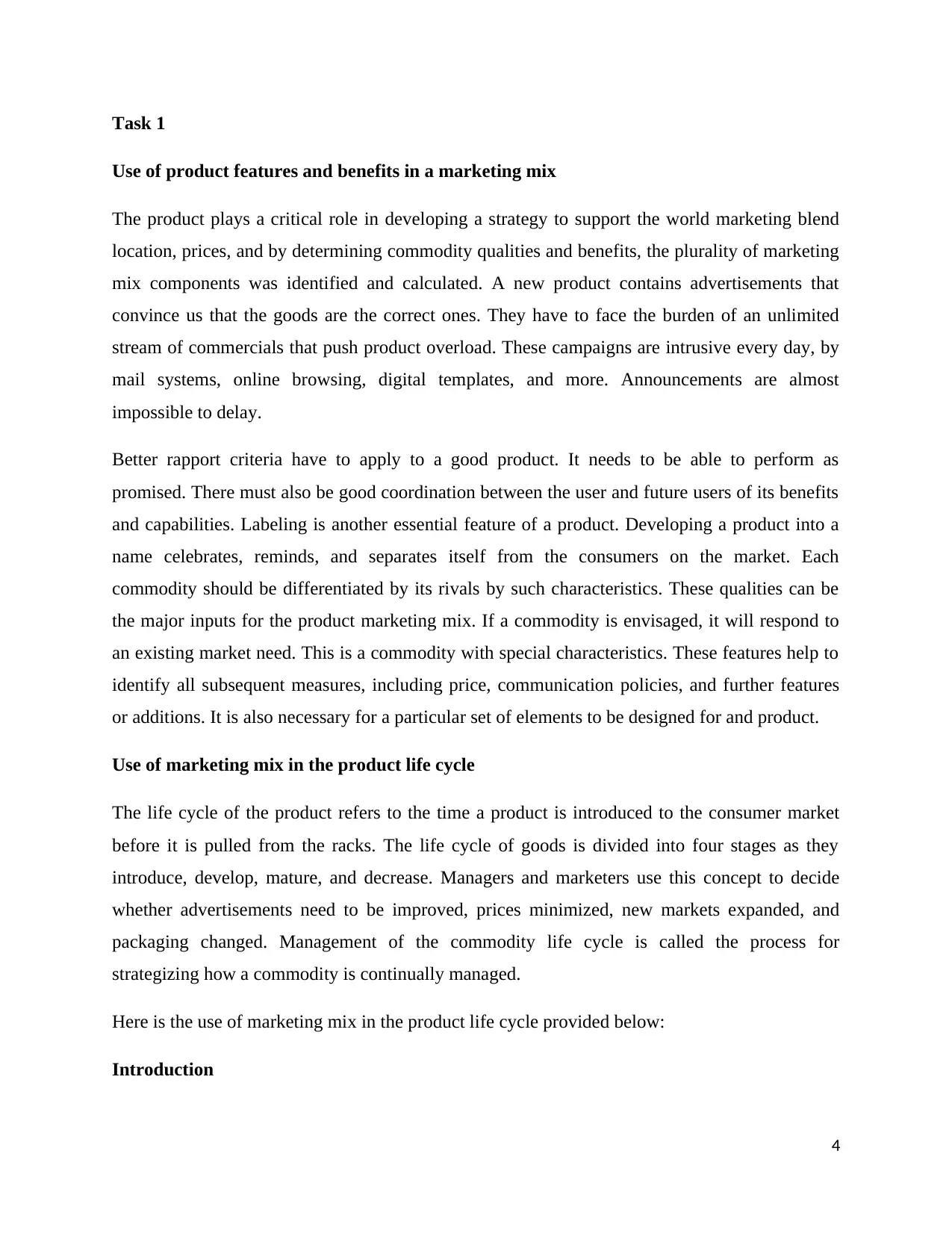
Task 1
Use of product features and benefits in a marketing mix
The product plays a critical role in developing a strategy to support the world marketing blend
location, prices, and by determining commodity qualities and benefits, the plurality of marketing
mix components was identified and calculated. A new product contains advertisements that
convince us that the goods are the correct ones. They have to face the burden of an unlimited
stream of commercials that push product overload. These campaigns are intrusive every day, by
mail systems, online browsing, digital templates, and more. Announcements are almost
impossible to delay.
Better rapport criteria have to apply to a good product. It needs to be able to perform as
promised. There must also be good coordination between the user and future users of its benefits
and capabilities. Labeling is another essential feature of a product. Developing a product into a
name celebrates, reminds, and separates itself from the consumers on the market. Each
commodity should be differentiated by its rivals by such characteristics. These qualities can be
the major inputs for the product marketing mix. If a commodity is envisaged, it will respond to
an existing market need. This is a commodity with special characteristics. These features help to
identify all subsequent measures, including price, communication policies, and further features
or additions. It is also necessary for a particular set of elements to be designed for and product.
Use of marketing mix in the product life cycle
The life cycle of the product refers to the time a product is introduced to the consumer market
before it is pulled from the racks. The life cycle of goods is divided into four stages as they
introduce, develop, mature, and decrease. Managers and marketers use this concept to decide
whether advertisements need to be improved, prices minimized, new markets expanded, and
packaging changed. Management of the commodity life cycle is called the process for
strategizing how a commodity is continually managed.
Here is the use of marketing mix in the product life cycle provided below:
Introduction
4
Use of product features and benefits in a marketing mix
The product plays a critical role in developing a strategy to support the world marketing blend
location, prices, and by determining commodity qualities and benefits, the plurality of marketing
mix components was identified and calculated. A new product contains advertisements that
convince us that the goods are the correct ones. They have to face the burden of an unlimited
stream of commercials that push product overload. These campaigns are intrusive every day, by
mail systems, online browsing, digital templates, and more. Announcements are almost
impossible to delay.
Better rapport criteria have to apply to a good product. It needs to be able to perform as
promised. There must also be good coordination between the user and future users of its benefits
and capabilities. Labeling is another essential feature of a product. Developing a product into a
name celebrates, reminds, and separates itself from the consumers on the market. Each
commodity should be differentiated by its rivals by such characteristics. These qualities can be
the major inputs for the product marketing mix. If a commodity is envisaged, it will respond to
an existing market need. This is a commodity with special characteristics. These features help to
identify all subsequent measures, including price, communication policies, and further features
or additions. It is also necessary for a particular set of elements to be designed for and product.
Use of marketing mix in the product life cycle
The life cycle of the product refers to the time a product is introduced to the consumer market
before it is pulled from the racks. The life cycle of goods is divided into four stages as they
introduce, develop, mature, and decrease. Managers and marketers use this concept to decide
whether advertisements need to be improved, prices minimized, new markets expanded, and
packaging changed. Management of the commodity life cycle is called the process for
strategizing how a commodity is continually managed.
Here is the use of marketing mix in the product life cycle provided below:
Introduction
4
Paraphrase This Document
Need a fresh take? Get an instant paraphrase of this document with our AI Paraphraser
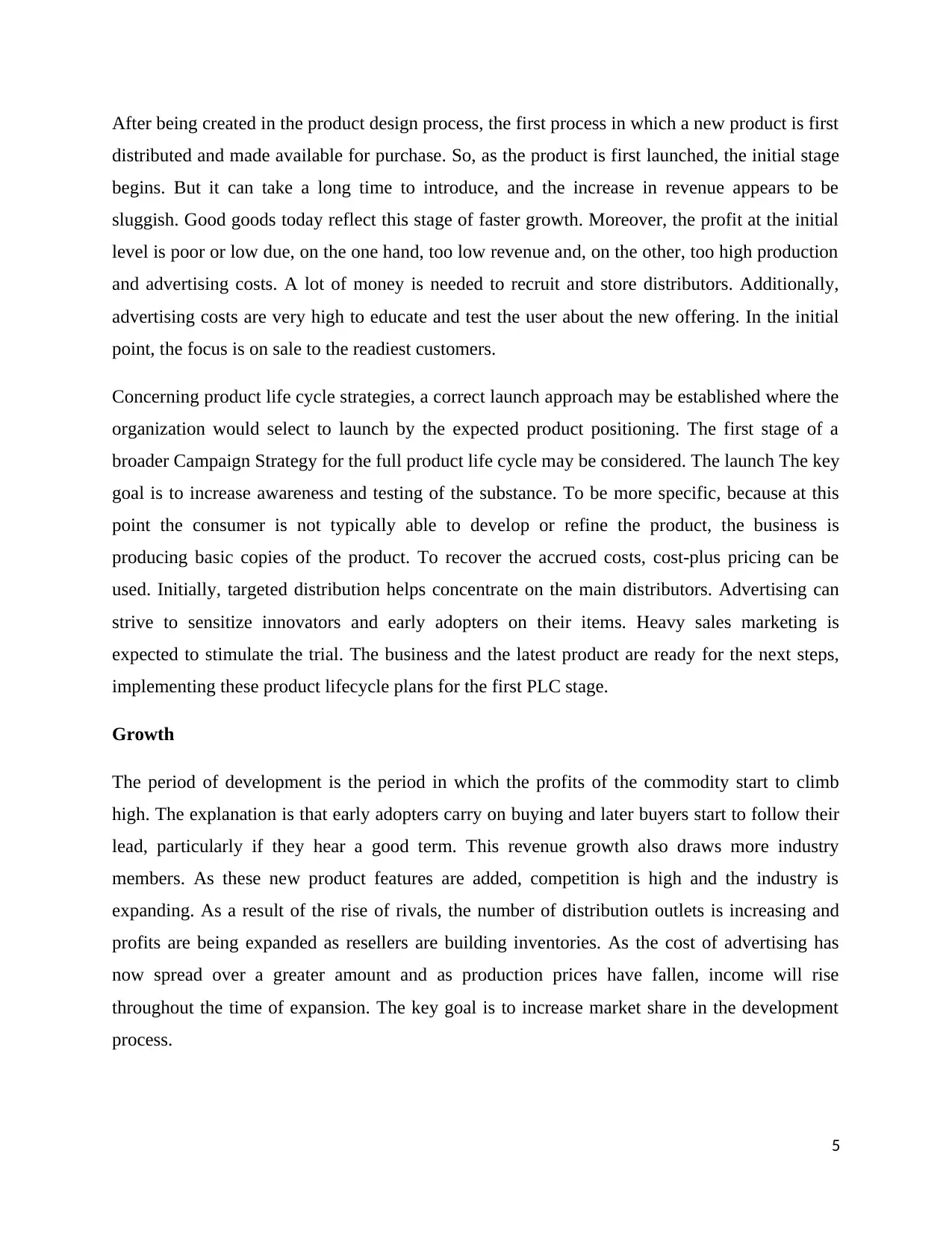
After being created in the product design process, the first process in which a new product is first
distributed and made available for purchase. So, as the product is first launched, the initial stage
begins. But it can take a long time to introduce, and the increase in revenue appears to be
sluggish. Good goods today reflect this stage of faster growth. Moreover, the profit at the initial
level is poor or low due, on the one hand, too low revenue and, on the other, too high production
and advertising costs. A lot of money is needed to recruit and store distributors. Additionally,
advertising costs are very high to educate and test the user about the new offering. In the initial
point, the focus is on sale to the readiest customers.
Concerning product life cycle strategies, a correct launch approach may be established where the
organization would select to launch by the expected product positioning. The first stage of a
broader Campaign Strategy for the full product life cycle may be considered. The launch The key
goal is to increase awareness and testing of the substance. To be more specific, because at this
point the consumer is not typically able to develop or refine the product, the business is
producing basic copies of the product. To recover the accrued costs, cost-plus pricing can be
used. Initially, targeted distribution helps concentrate on the main distributors. Advertising can
strive to sensitize innovators and early adopters on their items. Heavy sales marketing is
expected to stimulate the trial. The business and the latest product are ready for the next steps,
implementing these product lifecycle plans for the first PLC stage.
Growth
The period of development is the period in which the profits of the commodity start to climb
high. The explanation is that early adopters carry on buying and later buyers start to follow their
lead, particularly if they hear a good term. This revenue growth also draws more industry
members. As these new product features are added, competition is high and the industry is
expanding. As a result of the rise of rivals, the number of distribution outlets is increasing and
profits are being expanded as resellers are building inventories. As the cost of advertising has
now spread over a greater amount and as production prices have fallen, income will rise
throughout the time of expansion. The key goal is to increase market share in the development
process.
5
distributed and made available for purchase. So, as the product is first launched, the initial stage
begins. But it can take a long time to introduce, and the increase in revenue appears to be
sluggish. Good goods today reflect this stage of faster growth. Moreover, the profit at the initial
level is poor or low due, on the one hand, too low revenue and, on the other, too high production
and advertising costs. A lot of money is needed to recruit and store distributors. Additionally,
advertising costs are very high to educate and test the user about the new offering. In the initial
point, the focus is on sale to the readiest customers.
Concerning product life cycle strategies, a correct launch approach may be established where the
organization would select to launch by the expected product positioning. The first stage of a
broader Campaign Strategy for the full product life cycle may be considered. The launch The key
goal is to increase awareness and testing of the substance. To be more specific, because at this
point the consumer is not typically able to develop or refine the product, the business is
producing basic copies of the product. To recover the accrued costs, cost-plus pricing can be
used. Initially, targeted distribution helps concentrate on the main distributors. Advertising can
strive to sensitize innovators and early adopters on their items. Heavy sales marketing is
expected to stimulate the trial. The business and the latest product are ready for the next steps,
implementing these product lifecycle plans for the first PLC stage.
Growth
The period of development is the period in which the profits of the commodity start to climb
high. The explanation is that early adopters carry on buying and later buyers start to follow their
lead, particularly if they hear a good term. This revenue growth also draws more industry
members. As these new product features are added, competition is high and the industry is
expanding. As a result of the rise of rivals, the number of distribution outlets is increasing and
profits are being expanded as resellers are building inventories. As the cost of advertising has
now spread over a greater amount and as production prices have fallen, income will rise
throughout the time of expansion. The key goal is to increase market share in the development
process.
5
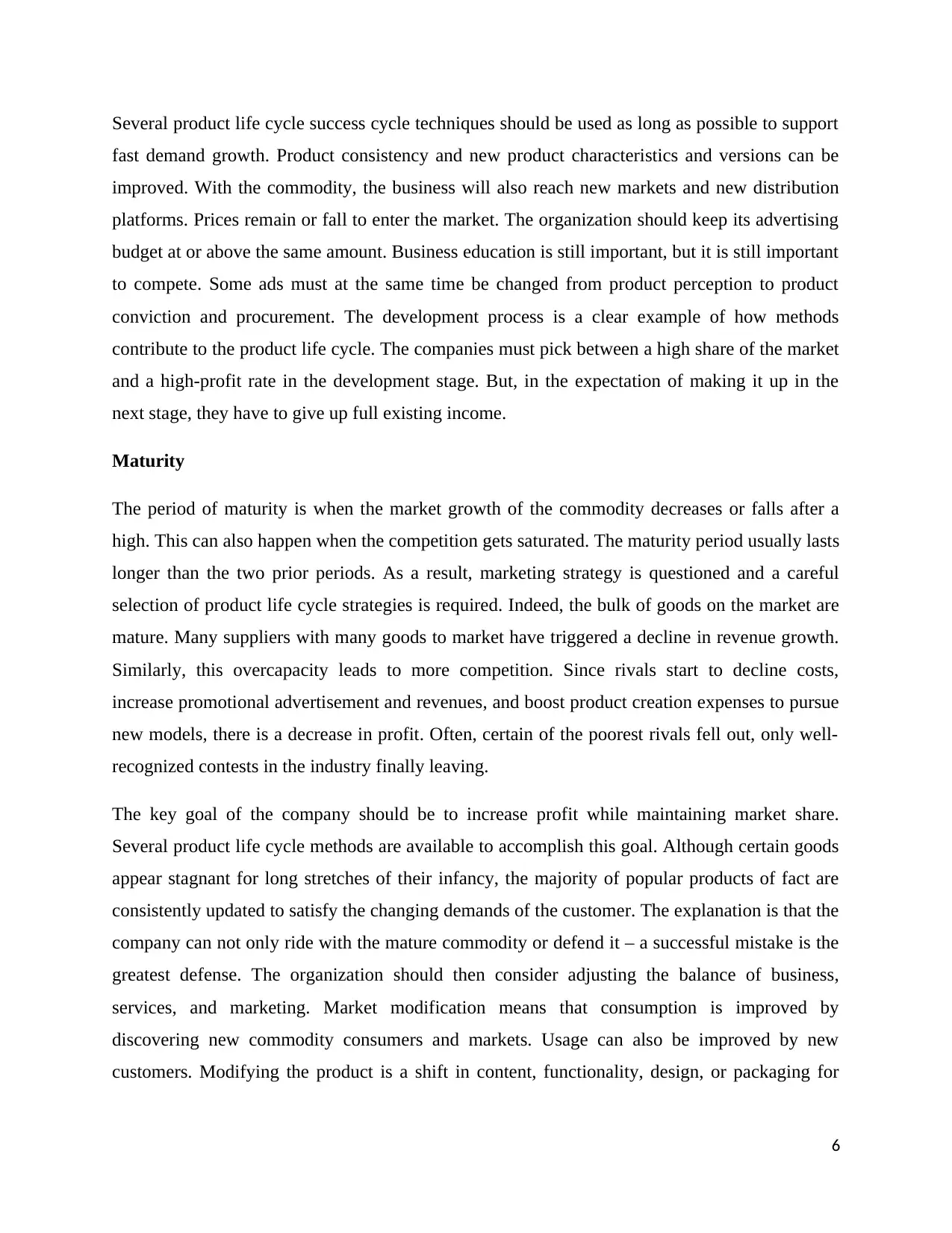
Several product life cycle success cycle techniques should be used as long as possible to support
fast demand growth. Product consistency and new product characteristics and versions can be
improved. With the commodity, the business will also reach new markets and new distribution
platforms. Prices remain or fall to enter the market. The organization should keep its advertising
budget at or above the same amount. Business education is still important, but it is still important
to compete. Some ads must at the same time be changed from product perception to product
conviction and procurement. The development process is a clear example of how methods
contribute to the product life cycle. The companies must pick between a high share of the market
and a high-profit rate in the development stage. But, in the expectation of making it up in the
next stage, they have to give up full existing income.
Maturity
The period of maturity is when the market growth of the commodity decreases or falls after a
high. This can also happen when the competition gets saturated. The maturity period usually lasts
longer than the two prior periods. As a result, marketing strategy is questioned and a careful
selection of product life cycle strategies is required. Indeed, the bulk of goods on the market are
mature. Many suppliers with many goods to market have triggered a decline in revenue growth.
Similarly, this overcapacity leads to more competition. Since rivals start to decline costs,
increase promotional advertisement and revenues, and boost product creation expenses to pursue
new models, there is a decrease in profit. Often, certain of the poorest rivals fell out, only well-
recognized contests in the industry finally leaving.
The key goal of the company should be to increase profit while maintaining market share.
Several product life cycle methods are available to accomplish this goal. Although certain goods
appear stagnant for long stretches of their infancy, the majority of popular products of fact are
consistently updated to satisfy the changing demands of the customer. The explanation is that the
company can not only ride with the mature commodity or defend it – a successful mistake is the
greatest defense. The organization should then consider adjusting the balance of business,
services, and marketing. Market modification means that consumption is improved by
discovering new commodity consumers and markets. Usage can also be improved by new
customers. Modifying the product is a shift in content, functionality, design, or packaging for
6
fast demand growth. Product consistency and new product characteristics and versions can be
improved. With the commodity, the business will also reach new markets and new distribution
platforms. Prices remain or fall to enter the market. The organization should keep its advertising
budget at or above the same amount. Business education is still important, but it is still important
to compete. Some ads must at the same time be changed from product perception to product
conviction and procurement. The development process is a clear example of how methods
contribute to the product life cycle. The companies must pick between a high share of the market
and a high-profit rate in the development stage. But, in the expectation of making it up in the
next stage, they have to give up full existing income.
Maturity
The period of maturity is when the market growth of the commodity decreases or falls after a
high. This can also happen when the competition gets saturated. The maturity period usually lasts
longer than the two prior periods. As a result, marketing strategy is questioned and a careful
selection of product life cycle strategies is required. Indeed, the bulk of goods on the market are
mature. Many suppliers with many goods to market have triggered a decline in revenue growth.
Similarly, this overcapacity leads to more competition. Since rivals start to decline costs,
increase promotional advertisement and revenues, and boost product creation expenses to pursue
new models, there is a decrease in profit. Often, certain of the poorest rivals fell out, only well-
recognized contests in the industry finally leaving.
The key goal of the company should be to increase profit while maintaining market share.
Several product life cycle methods are available to accomplish this goal. Although certain goods
appear stagnant for long stretches of their infancy, the majority of popular products of fact are
consistently updated to satisfy the changing demands of the customer. The explanation is that the
company can not only ride with the mature commodity or defend it – a successful mistake is the
greatest defense. The organization should then consider adjusting the balance of business,
services, and marketing. Market modification means that consumption is improved by
discovering new commodity consumers and markets. Usage can also be improved by new
customers. Modifying the product is a shift in content, functionality, design, or packaging for
6
⊘ This is a preview!⊘
Do you want full access?
Subscribe today to unlock all pages.

Trusted by 1+ million students worldwide
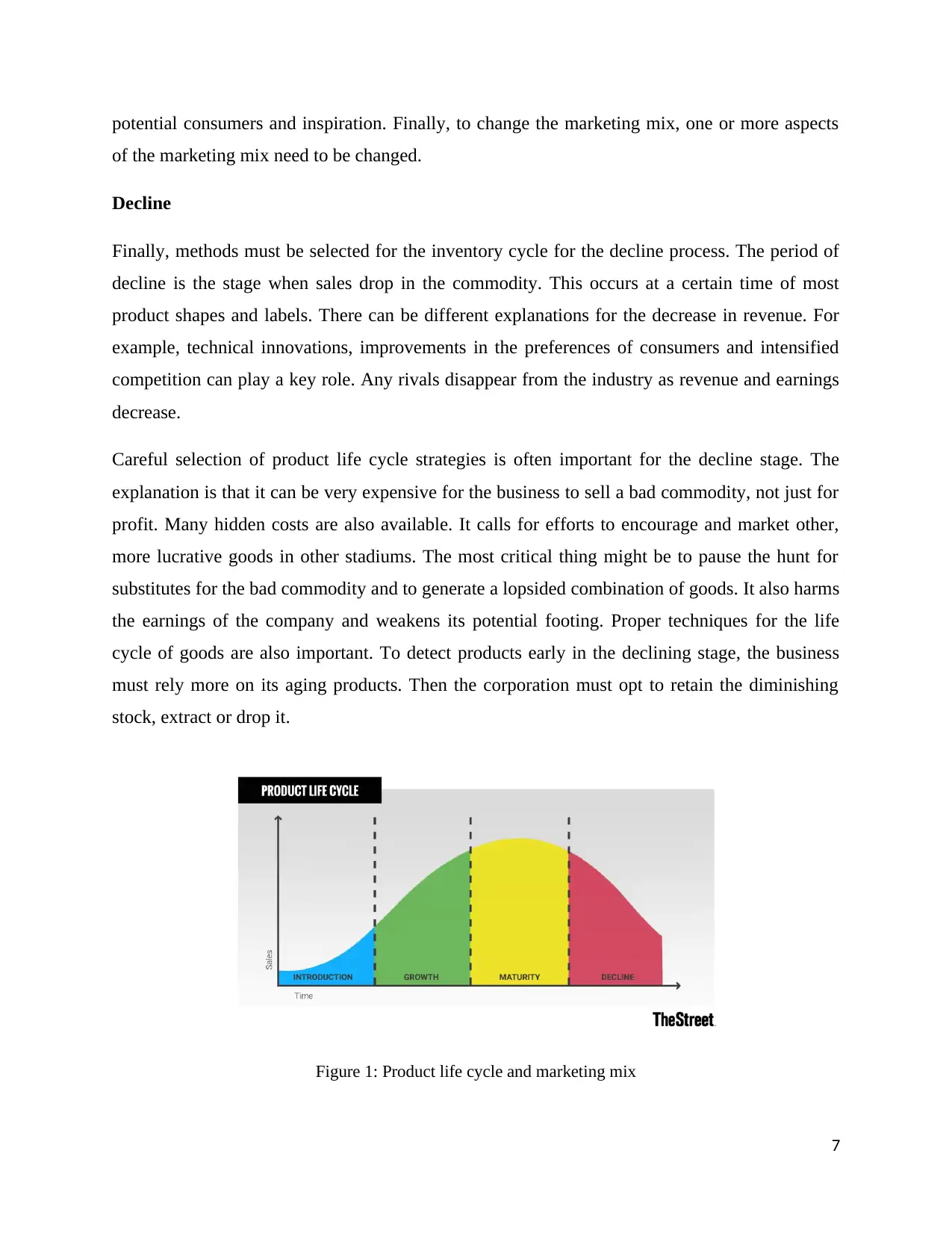
potential consumers and inspiration. Finally, to change the marketing mix, one or more aspects
of the marketing mix need to be changed.
Decline
Finally, methods must be selected for the inventory cycle for the decline process. The period of
decline is the stage when sales drop in the commodity. This occurs at a certain time of most
product shapes and labels. There can be different explanations for the decrease in revenue. For
example, technical innovations, improvements in the preferences of consumers and intensified
competition can play a key role. Any rivals disappear from the industry as revenue and earnings
decrease.
Careful selection of product life cycle strategies is often important for the decline stage. The
explanation is that it can be very expensive for the business to sell a bad commodity, not just for
profit. Many hidden costs are also available. It calls for efforts to encourage and market other,
more lucrative goods in other stadiums. The most critical thing might be to pause the hunt for
substitutes for the bad commodity and to generate a lopsided combination of goods. It also harms
the earnings of the company and weakens its potential footing. Proper techniques for the life
cycle of goods are also important. To detect products early in the declining stage, the business
must rely more on its aging products. Then the corporation must opt to retain the diminishing
stock, extract or drop it.
Figure 1: Product life cycle and marketing mix
7
of the marketing mix need to be changed.
Decline
Finally, methods must be selected for the inventory cycle for the decline process. The period of
decline is the stage when sales drop in the commodity. This occurs at a certain time of most
product shapes and labels. There can be different explanations for the decrease in revenue. For
example, technical innovations, improvements in the preferences of consumers and intensified
competition can play a key role. Any rivals disappear from the industry as revenue and earnings
decrease.
Careful selection of product life cycle strategies is often important for the decline stage. The
explanation is that it can be very expensive for the business to sell a bad commodity, not just for
profit. Many hidden costs are also available. It calls for efforts to encourage and market other,
more lucrative goods in other stadiums. The most critical thing might be to pause the hunt for
substitutes for the bad commodity and to generate a lopsided combination of goods. It also harms
the earnings of the company and weakens its potential footing. Proper techniques for the life
cycle of goods are also important. To detect products early in the declining stage, the business
must rely more on its aging products. Then the corporation must opt to retain the diminishing
stock, extract or drop it.
Figure 1: Product life cycle and marketing mix
7
Paraphrase This Document
Need a fresh take? Get an instant paraphrase of this document with our AI Paraphraser
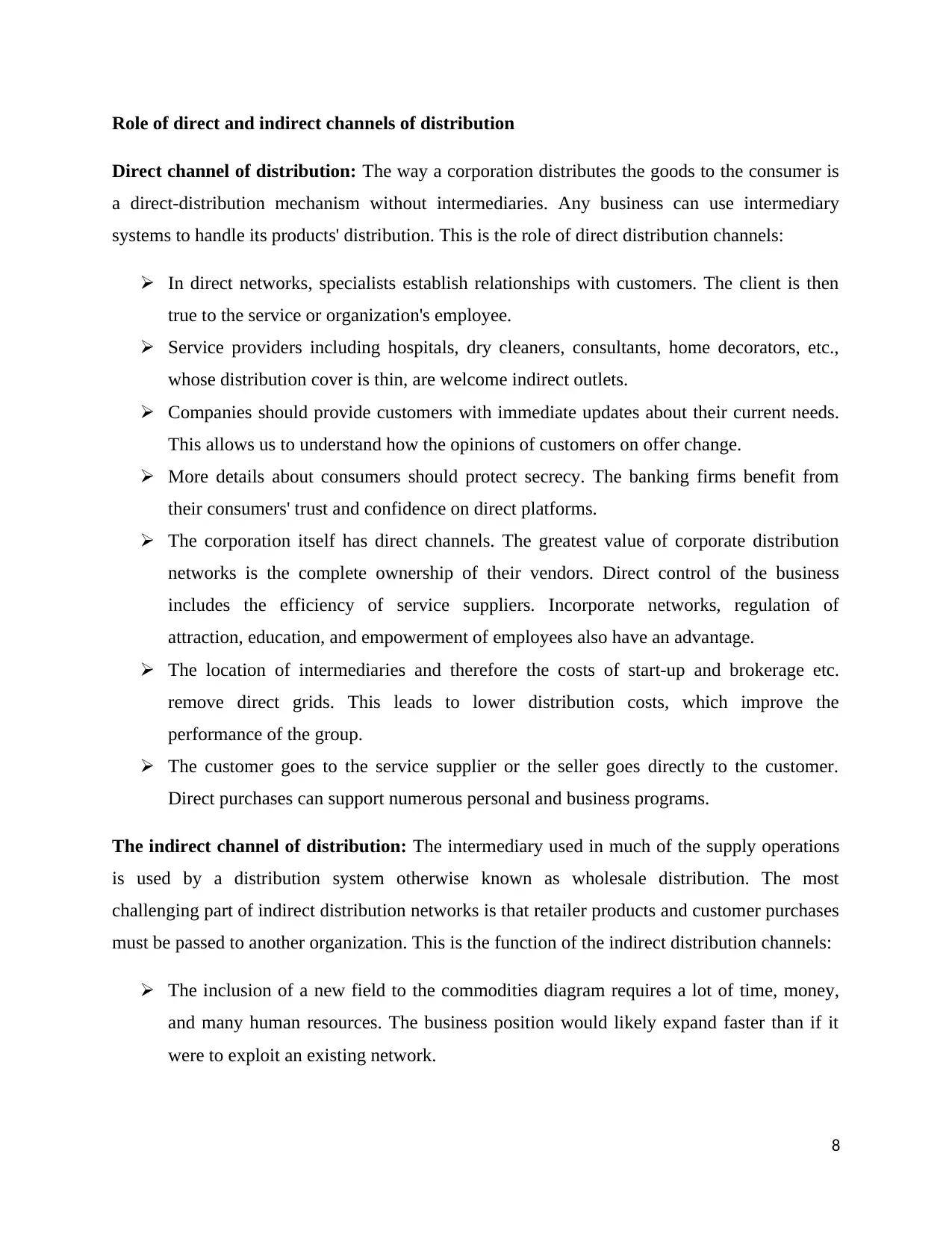
Role of direct and indirect channels of distribution
Direct channel of distribution: The way a corporation distributes the goods to the consumer is
a direct-distribution mechanism without intermediaries. Any business can use intermediary
systems to handle its products' distribution. This is the role of direct distribution channels:
In direct networks, specialists establish relationships with customers. The client is then
true to the service or organization's employee.
Service providers including hospitals, dry cleaners, consultants, home decorators, etc.,
whose distribution cover is thin, are welcome indirect outlets.
Companies should provide customers with immediate updates about their current needs.
This allows us to understand how the opinions of customers on offer change.
More details about consumers should protect secrecy. The banking firms benefit from
their consumers' trust and confidence on direct platforms.
The corporation itself has direct channels. The greatest value of corporate distribution
networks is the complete ownership of their vendors. Direct control of the business
includes the efficiency of service suppliers. Incorporate networks, regulation of
attraction, education, and empowerment of employees also have an advantage.
The location of intermediaries and therefore the costs of start-up and brokerage etc.
remove direct grids. This leads to lower distribution costs, which improve the
performance of the group.
The customer goes to the service supplier or the seller goes directly to the customer.
Direct purchases can support numerous personal and business programs.
The indirect channel of distribution: The intermediary used in much of the supply operations
is used by a distribution system otherwise known as wholesale distribution. The most
challenging part of indirect distribution networks is that retailer products and customer purchases
must be passed to another organization. This is the function of the indirect distribution channels:
The inclusion of a new field to the commodities diagram requires a lot of time, money,
and many human resources. The business position would likely expand faster than if it
were to exploit an existing network.
8
Direct channel of distribution: The way a corporation distributes the goods to the consumer is
a direct-distribution mechanism without intermediaries. Any business can use intermediary
systems to handle its products' distribution. This is the role of direct distribution channels:
In direct networks, specialists establish relationships with customers. The client is then
true to the service or organization's employee.
Service providers including hospitals, dry cleaners, consultants, home decorators, etc.,
whose distribution cover is thin, are welcome indirect outlets.
Companies should provide customers with immediate updates about their current needs.
This allows us to understand how the opinions of customers on offer change.
More details about consumers should protect secrecy. The banking firms benefit from
their consumers' trust and confidence on direct platforms.
The corporation itself has direct channels. The greatest value of corporate distribution
networks is the complete ownership of their vendors. Direct control of the business
includes the efficiency of service suppliers. Incorporate networks, regulation of
attraction, education, and empowerment of employees also have an advantage.
The location of intermediaries and therefore the costs of start-up and brokerage etc.
remove direct grids. This leads to lower distribution costs, which improve the
performance of the group.
The customer goes to the service supplier or the seller goes directly to the customer.
Direct purchases can support numerous personal and business programs.
The indirect channel of distribution: The intermediary used in much of the supply operations
is used by a distribution system otherwise known as wholesale distribution. The most
challenging part of indirect distribution networks is that retailer products and customer purchases
must be passed to another organization. This is the function of the indirect distribution channels:
The inclusion of a new field to the commodities diagram requires a lot of time, money,
and many human resources. The business position would likely expand faster than if it
were to exploit an existing network.
8
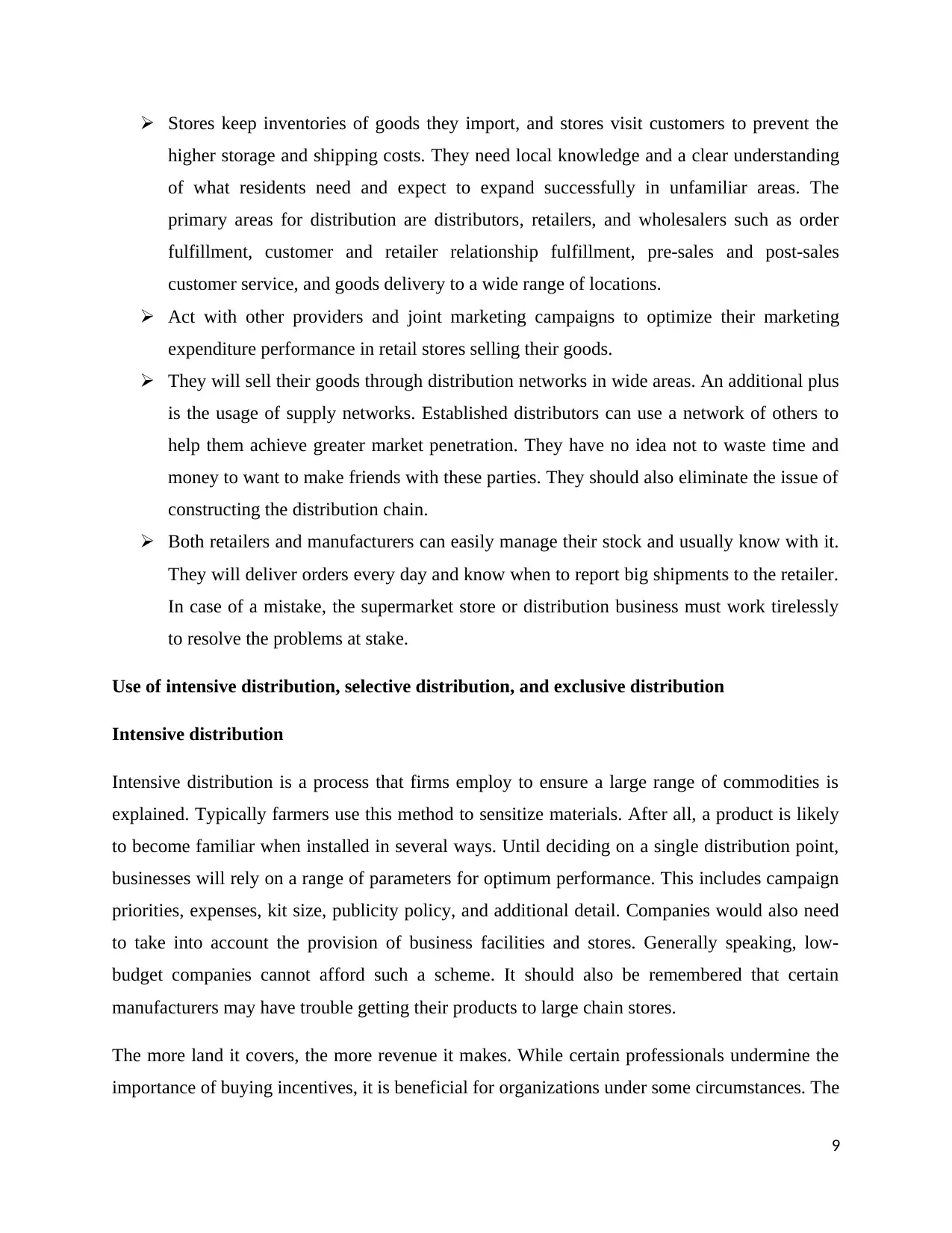
Stores keep inventories of goods they import, and stores visit customers to prevent the
higher storage and shipping costs. They need local knowledge and a clear understanding
of what residents need and expect to expand successfully in unfamiliar areas. The
primary areas for distribution are distributors, retailers, and wholesalers such as order
fulfillment, customer and retailer relationship fulfillment, pre-sales and post-sales
customer service, and goods delivery to a wide range of locations.
Act with other providers and joint marketing campaigns to optimize their marketing
expenditure performance in retail stores selling their goods.
They will sell their goods through distribution networks in wide areas. An additional plus
is the usage of supply networks. Established distributors can use a network of others to
help them achieve greater market penetration. They have no idea not to waste time and
money to want to make friends with these parties. They should also eliminate the issue of
constructing the distribution chain.
Both retailers and manufacturers can easily manage their stock and usually know with it.
They will deliver orders every day and know when to report big shipments to the retailer.
In case of a mistake, the supermarket store or distribution business must work tirelessly
to resolve the problems at stake.
Use of intensive distribution, selective distribution, and exclusive distribution
Intensive distribution
Intensive distribution is a process that firms employ to ensure a large range of commodities is
explained. Typically farmers use this method to sensitize materials. After all, a product is likely
to become familiar when installed in several ways. Until deciding on a single distribution point,
businesses will rely on a range of parameters for optimum performance. This includes campaign
priorities, expenses, kit size, publicity policy, and additional detail. Companies would also need
to take into account the provision of business facilities and stores. Generally speaking, low-
budget companies cannot afford such a scheme. It should also be remembered that certain
manufacturers may have trouble getting their products to large chain stores.
The more land it covers, the more revenue it makes. While certain professionals undermine the
importance of buying incentives, it is beneficial for organizations under some circumstances. The
9
higher storage and shipping costs. They need local knowledge and a clear understanding
of what residents need and expect to expand successfully in unfamiliar areas. The
primary areas for distribution are distributors, retailers, and wholesalers such as order
fulfillment, customer and retailer relationship fulfillment, pre-sales and post-sales
customer service, and goods delivery to a wide range of locations.
Act with other providers and joint marketing campaigns to optimize their marketing
expenditure performance in retail stores selling their goods.
They will sell their goods through distribution networks in wide areas. An additional plus
is the usage of supply networks. Established distributors can use a network of others to
help them achieve greater market penetration. They have no idea not to waste time and
money to want to make friends with these parties. They should also eliminate the issue of
constructing the distribution chain.
Both retailers and manufacturers can easily manage their stock and usually know with it.
They will deliver orders every day and know when to report big shipments to the retailer.
In case of a mistake, the supermarket store or distribution business must work tirelessly
to resolve the problems at stake.
Use of intensive distribution, selective distribution, and exclusive distribution
Intensive distribution
Intensive distribution is a process that firms employ to ensure a large range of commodities is
explained. Typically farmers use this method to sensitize materials. After all, a product is likely
to become familiar when installed in several ways. Until deciding on a single distribution point,
businesses will rely on a range of parameters for optimum performance. This includes campaign
priorities, expenses, kit size, publicity policy, and additional detail. Companies would also need
to take into account the provision of business facilities and stores. Generally speaking, low-
budget companies cannot afford such a scheme. It should also be remembered that certain
manufacturers may have trouble getting their products to large chain stores.
The more land it covers, the more revenue it makes. While certain professionals undermine the
importance of buying incentives, it is beneficial for organizations under some circumstances. The
9
⊘ This is a preview!⊘
Do you want full access?
Subscribe today to unlock all pages.

Trusted by 1+ million students worldwide
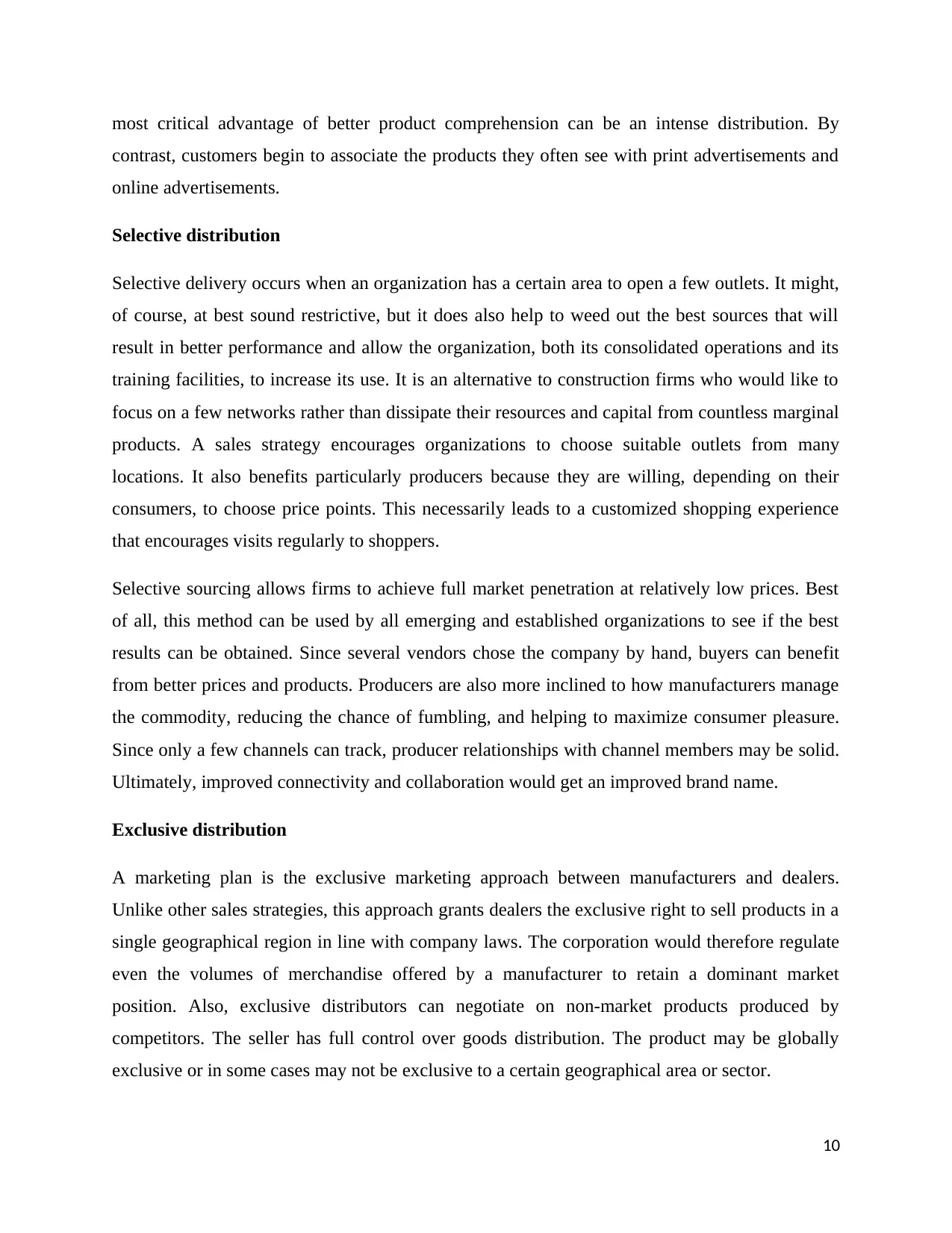
most critical advantage of better product comprehension can be an intense distribution. By
contrast, customers begin to associate the products they often see with print advertisements and
online advertisements.
Selective distribution
Selective delivery occurs when an organization has a certain area to open a few outlets. It might,
of course, at best sound restrictive, but it does also help to weed out the best sources that will
result in better performance and allow the organization, both its consolidated operations and its
training facilities, to increase its use. It is an alternative to construction firms who would like to
focus on a few networks rather than dissipate their resources and capital from countless marginal
products. A sales strategy encourages organizations to choose suitable outlets from many
locations. It also benefits particularly producers because they are willing, depending on their
consumers, to choose price points. This necessarily leads to a customized shopping experience
that encourages visits regularly to shoppers.
Selective sourcing allows firms to achieve full market penetration at relatively low prices. Best
of all, this method can be used by all emerging and established organizations to see if the best
results can be obtained. Since several vendors chose the company by hand, buyers can benefit
from better prices and products. Producers are also more inclined to how manufacturers manage
the commodity, reducing the chance of fumbling, and helping to maximize consumer pleasure.
Since only a few channels can track, producer relationships with channel members may be solid.
Ultimately, improved connectivity and collaboration would get an improved brand name.
Exclusive distribution
A marketing plan is the exclusive marketing approach between manufacturers and dealers.
Unlike other sales strategies, this approach grants dealers the exclusive right to sell products in a
single geographical region in line with company laws. The corporation would therefore regulate
even the volumes of merchandise offered by a manufacturer to retain a dominant market
position. Also, exclusive distributors can negotiate on non-market products produced by
competitors. The seller has full control over goods distribution. The product may be globally
exclusive or in some cases may not be exclusive to a certain geographical area or sector.
10
contrast, customers begin to associate the products they often see with print advertisements and
online advertisements.
Selective distribution
Selective delivery occurs when an organization has a certain area to open a few outlets. It might,
of course, at best sound restrictive, but it does also help to weed out the best sources that will
result in better performance and allow the organization, both its consolidated operations and its
training facilities, to increase its use. It is an alternative to construction firms who would like to
focus on a few networks rather than dissipate their resources and capital from countless marginal
products. A sales strategy encourages organizations to choose suitable outlets from many
locations. It also benefits particularly producers because they are willing, depending on their
consumers, to choose price points. This necessarily leads to a customized shopping experience
that encourages visits regularly to shoppers.
Selective sourcing allows firms to achieve full market penetration at relatively low prices. Best
of all, this method can be used by all emerging and established organizations to see if the best
results can be obtained. Since several vendors chose the company by hand, buyers can benefit
from better prices and products. Producers are also more inclined to how manufacturers manage
the commodity, reducing the chance of fumbling, and helping to maximize consumer pleasure.
Since only a few channels can track, producer relationships with channel members may be solid.
Ultimately, improved connectivity and collaboration would get an improved brand name.
Exclusive distribution
A marketing plan is the exclusive marketing approach between manufacturers and dealers.
Unlike other sales strategies, this approach grants dealers the exclusive right to sell products in a
single geographical region in line with company laws. The corporation would therefore regulate
even the volumes of merchandise offered by a manufacturer to retain a dominant market
position. Also, exclusive distributors can negotiate on non-market products produced by
competitors. The seller has full control over goods distribution. The product may be globally
exclusive or in some cases may not be exclusive to a certain geographical area or sector.
10
Paraphrase This Document
Need a fresh take? Get an instant paraphrase of this document with our AI Paraphraser
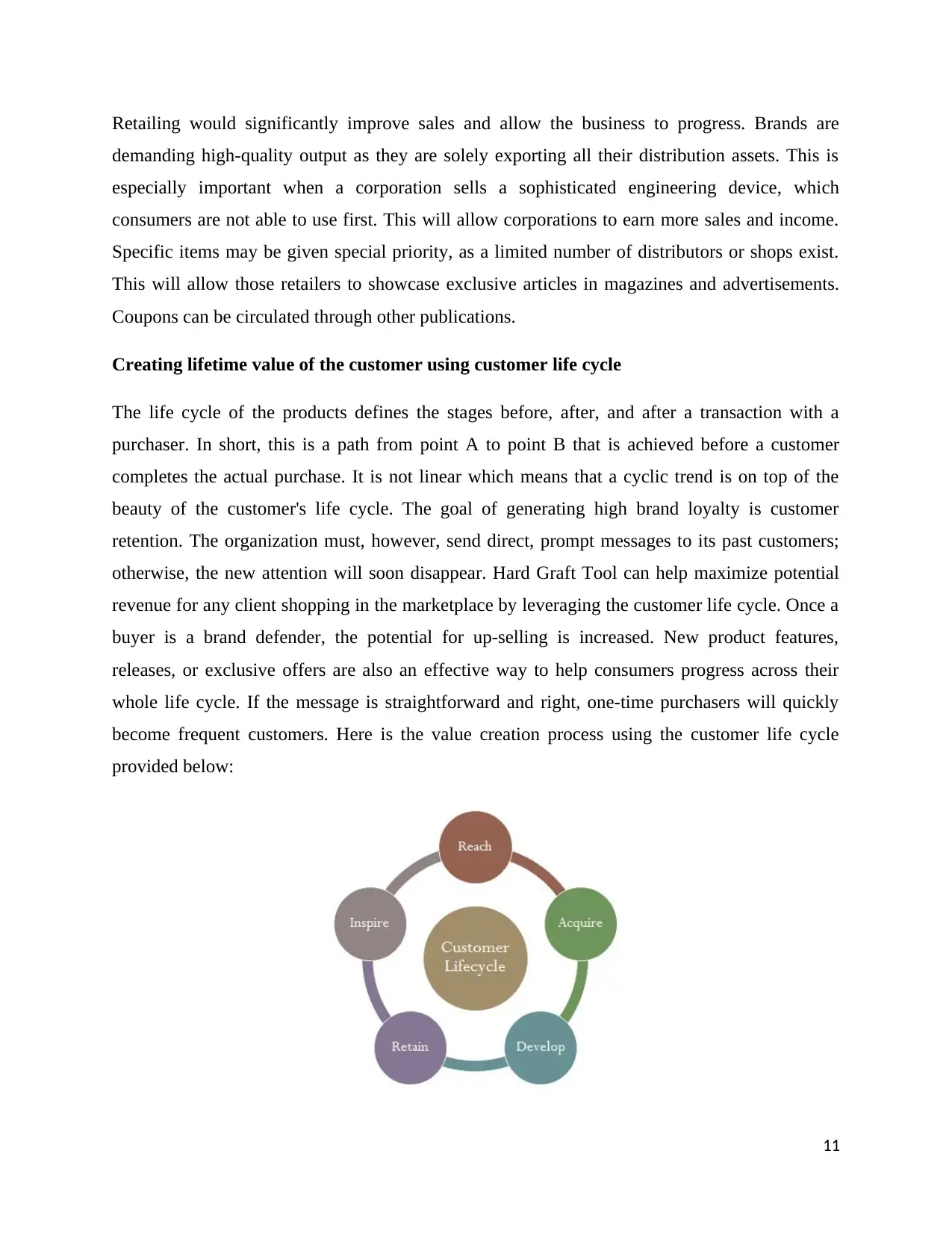
Retailing would significantly improve sales and allow the business to progress. Brands are
demanding high-quality output as they are solely exporting all their distribution assets. This is
especially important when a corporation sells a sophisticated engineering device, which
consumers are not able to use first. This will allow corporations to earn more sales and income.
Specific items may be given special priority, as a limited number of distributors or shops exist.
This will allow those retailers to showcase exclusive articles in magazines and advertisements.
Coupons can be circulated through other publications.
Creating lifetime value of the customer using customer life cycle
The life cycle of the products defines the stages before, after, and after a transaction with a
purchaser. In short, this is a path from point A to point B that is achieved before a customer
completes the actual purchase. It is not linear which means that a cyclic trend is on top of the
beauty of the customer's life cycle. The goal of generating high brand loyalty is customer
retention. The organization must, however, send direct, prompt messages to its past customers;
otherwise, the new attention will soon disappear. Hard Graft Tool can help maximize potential
revenue for any client shopping in the marketplace by leveraging the customer life cycle. Once a
buyer is a brand defender, the potential for up-selling is increased. New product features,
releases, or exclusive offers are also an effective way to help consumers progress across their
whole life cycle. If the message is straightforward and right, one-time purchasers will quickly
become frequent customers. Here is the value creation process using the customer life cycle
provided below:
11
demanding high-quality output as they are solely exporting all their distribution assets. This is
especially important when a corporation sells a sophisticated engineering device, which
consumers are not able to use first. This will allow corporations to earn more sales and income.
Specific items may be given special priority, as a limited number of distributors or shops exist.
This will allow those retailers to showcase exclusive articles in magazines and advertisements.
Coupons can be circulated through other publications.
Creating lifetime value of the customer using customer life cycle
The life cycle of the products defines the stages before, after, and after a transaction with a
purchaser. In short, this is a path from point A to point B that is achieved before a customer
completes the actual purchase. It is not linear which means that a cyclic trend is on top of the
beauty of the customer's life cycle. The goal of generating high brand loyalty is customer
retention. The organization must, however, send direct, prompt messages to its past customers;
otherwise, the new attention will soon disappear. Hard Graft Tool can help maximize potential
revenue for any client shopping in the marketplace by leveraging the customer life cycle. Once a
buyer is a brand defender, the potential for up-selling is increased. New product features,
releases, or exclusive offers are also an effective way to help consumers progress across their
whole life cycle. If the message is straightforward and right, one-time purchasers will quickly
become frequent customers. Here is the value creation process using the customer life cycle
provided below:
11
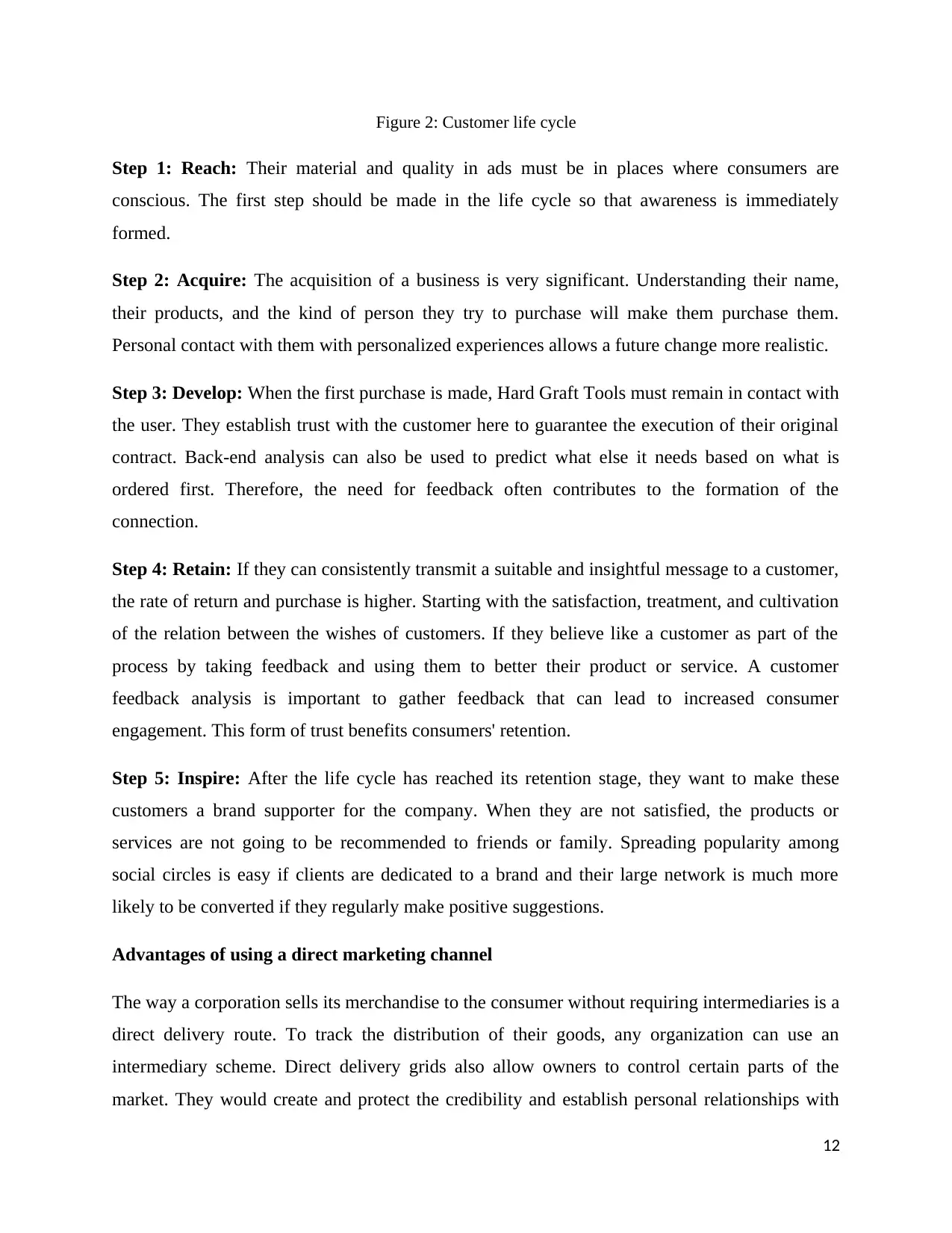
Figure 2: Customer life cycle
Step 1: Reach: Their material and quality in ads must be in places where consumers are
conscious. The first step should be made in the life cycle so that awareness is immediately
formed.
Step 2: Acquire: The acquisition of a business is very significant. Understanding their name,
their products, and the kind of person they try to purchase will make them purchase them.
Personal contact with them with personalized experiences allows a future change more realistic.
Step 3: Develop: When the first purchase is made, Hard Graft Tools must remain in contact with
the user. They establish trust with the customer here to guarantee the execution of their original
contract. Back-end analysis can also be used to predict what else it needs based on what is
ordered first. Therefore, the need for feedback often contributes to the formation of the
connection.
Step 4: Retain: If they can consistently transmit a suitable and insightful message to a customer,
the rate of return and purchase is higher. Starting with the satisfaction, treatment, and cultivation
of the relation between the wishes of customers. If they believe like a customer as part of the
process by taking feedback and using them to better their product or service. A customer
feedback analysis is important to gather feedback that can lead to increased consumer
engagement. This form of trust benefits consumers' retention.
Step 5: Inspire: After the life cycle has reached its retention stage, they want to make these
customers a brand supporter for the company. When they are not satisfied, the products or
services are not going to be recommended to friends or family. Spreading popularity among
social circles is easy if clients are dedicated to a brand and their large network is much more
likely to be converted if they regularly make positive suggestions.
Advantages of using a direct marketing channel
The way a corporation sells its merchandise to the consumer without requiring intermediaries is a
direct delivery route. To track the distribution of their goods, any organization can use an
intermediary scheme. Direct delivery grids also allow owners to control certain parts of the
market. They would create and protect the credibility and establish personal relationships with
12
Step 1: Reach: Their material and quality in ads must be in places where consumers are
conscious. The first step should be made in the life cycle so that awareness is immediately
formed.
Step 2: Acquire: The acquisition of a business is very significant. Understanding their name,
their products, and the kind of person they try to purchase will make them purchase them.
Personal contact with them with personalized experiences allows a future change more realistic.
Step 3: Develop: When the first purchase is made, Hard Graft Tools must remain in contact with
the user. They establish trust with the customer here to guarantee the execution of their original
contract. Back-end analysis can also be used to predict what else it needs based on what is
ordered first. Therefore, the need for feedback often contributes to the formation of the
connection.
Step 4: Retain: If they can consistently transmit a suitable and insightful message to a customer,
the rate of return and purchase is higher. Starting with the satisfaction, treatment, and cultivation
of the relation between the wishes of customers. If they believe like a customer as part of the
process by taking feedback and using them to better their product or service. A customer
feedback analysis is important to gather feedback that can lead to increased consumer
engagement. This form of trust benefits consumers' retention.
Step 5: Inspire: After the life cycle has reached its retention stage, they want to make these
customers a brand supporter for the company. When they are not satisfied, the products or
services are not going to be recommended to friends or family. Spreading popularity among
social circles is easy if clients are dedicated to a brand and their large network is much more
likely to be converted if they regularly make positive suggestions.
Advantages of using a direct marketing channel
The way a corporation sells its merchandise to the consumer without requiring intermediaries is a
direct delivery route. To track the distribution of their goods, any organization can use an
intermediary scheme. Direct delivery grids also allow owners to control certain parts of the
market. They would create and protect the credibility and establish personal relationships with
12
⊘ This is a preview!⊘
Do you want full access?
Subscribe today to unlock all pages.

Trusted by 1+ million students worldwide
1 out of 35
Related Documents
Your All-in-One AI-Powered Toolkit for Academic Success.
+13062052269
info@desklib.com
Available 24*7 on WhatsApp / Email
![[object Object]](/_next/static/media/star-bottom.7253800d.svg)
Unlock your academic potential
Copyright © 2020–2025 A2Z Services. All Rights Reserved. Developed and managed by ZUCOL.





